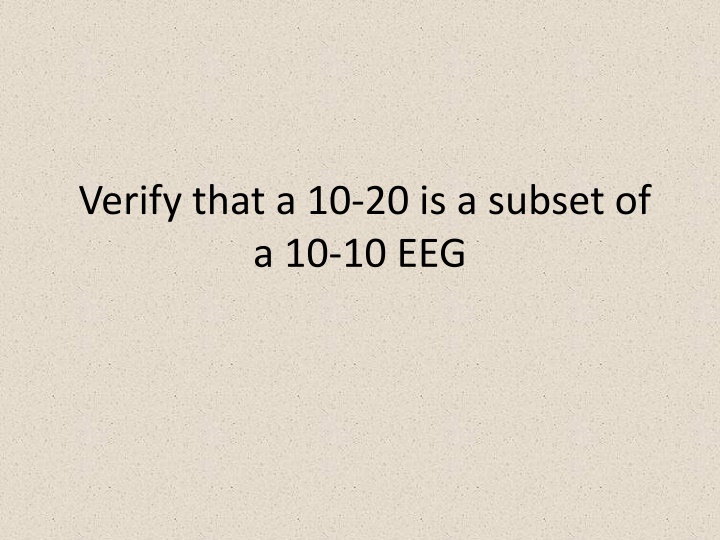
10-20 System Positioning for EEG Measurements
Learn how to accurately position electrodes using the 10-20 system for EEG measurements. Follow step-by-step instructions to mark key points such as Cz, Fpz, Oz, Fz, Pz, T3, and T4, ensuring precise and reliable readings. Utilize diagrams for visual guidance throughout the process.
Download Presentation

Please find below an Image/Link to download the presentation.
The content on the website is provided AS IS for your information and personal use only. It may not be sold, licensed, or shared on other websites without obtaining consent from the author. If you encounter any issues during the download, it is possible that the publisher has removed the file from their server.
You are allowed to download the files provided on this website for personal or commercial use, subject to the condition that they are used lawfully. All files are the property of their respective owners.
The content on the website is provided AS IS for your information and personal use only. It may not be sold, licensed, or shared on other websites without obtaining consent from the author.
E N D
Presentation Transcript
Verify that a 10-20 is a subset of a 10-10 EEG
10-20 system positioning 36 cm Measure over the center line of the scalp, from the Nasion (bridge of the nose) to the Inion (occipital pretu-berance). Note the total length.
10-20 system positioning Measure and mark 50% of your total. This is your preliminary Cz mark. 36/2=18cm
10-20 system positioning Measure and mark 10% up from the Nasion and 10% up from the Inion. These are your preliminary mark of Fpz and Oz. In our example 10% of 36 cm is 3.6 cm
10-20 system positioning Mark 20% from either the first mark of Fpz or Cz. These will be your preliminary marks of Fz and Pz. In our example 20% of 36 cm is 7.2 cm
10-20 system positioning Measure from preauricular point to preauricular- point. Lightly run your finger up and down just anterior to the ear; the indentation above the zygo- matic notch is easily identified. Opening the mouth slightly makes it easier to find the exact location. Note the total length. 34 cm
10-20 system positioning Measure and mark 50% of your total. In our example: 34/2=17 cm At the intersection with your previous 50% mark from the Nasion to the Inion is your true Cz mark.
10-20 system positioning Measure and mark 10% up from the pre auricular points. These are your preliminary marks of T3 and T4. In our example 10% of 34 cm is 3.4 cm
10-20 system positioning Measure from your first mark of T3 to Cz. Note the total length. Measure from your first mark of T4 to Cz. Note the total length. E.g. : 14 cm
10-20 system positioning Measure and mark 50% of the totals in the previous step. These are your preliminary marks of C3 and C4. f12/2 =7 cm Or In our example 20% of 34 cm is 6.8 cm.
10-20 system positioning Draw a cross section mark on Fpz. This is your true Fpz mark. .
10-20 system positioning Find circumference of head from Oz Through T 3 and T4 and Fpz. For our example 56 cm. Measure 50% of the total circumference from Fpz to the back of the head. At the cross section with your preliminary Oz mark is your true Oz mark. In our example 20% of 54 cm is 27 cm.
10-20 system positioning Measure and mark 5% of total circumference to the left and right of Oz. These will be your true marks of O1 and O2. In our example 5% of 56 cm = 2.8 cm
10-20 system positioning Measure and mark 5% of total circumference to the left and right of Fpz. These will be your true Fp1 and Fp2 marks. In our example 5% of 56 cm = 2.8 cm
10-20 system positioning Measure and mark 10% down from Fp1 and Fp2. These are your marks for F7 and F8. In our example 10% of 56 cm = 5.6 cm
10-20 system positioning Measure from F7 to F8 and note your distance. For our example 32 cm
10-20 system positioning Measure and mark half of the distance between F7 and F8. At the intersection with your preliminary Fz mark is the true mark for Fz. In our example 32/ 2 = 16 cm
10-20 system positioning Measure and mark half of the distance between F7- Fz and F8-Fz. These are your preliminary marks for F3 and F4. In our example 16 cm / 2 = 8 cm
10-20 system positioning Measure and mark 20% of the Nasion-Inion distance from FP1 to F3. At the intersection will be your true F3 mark. Measure and mark 20% of the Nasion-Inion distance from FP2 to F4. At the intersection will be your true F4 mark. In our example 20% of 36 cm = 7 cm
10-20 system positioning Measure from Fp1 to O1, to obtain your preliminary mark of C3. Measure from Fp2 to O2 to obtain your preliminary mark of C3. For our example 28 cm
10-20 system positioning Measure and mark half of the distance Fp1-O1. Where your first and second marks intersect will be your true C3. Measure and mark half of the distance Fp2-O2. Where your first and second marks intersect will be your true C4. In our example 28 cm / 2 = 14 cm
10-20 system positioning 21 electrode Increasing need for higher density electrode setting. Therefore 10-10 system was introduced.
10-10 system positioning 75 electrodes Divided from Nz to Iz LPA to RPA, in 10% increments.
Conclusion 10-20 system positioning is subset of 10-10 system positioning.
References [1] A. M. Husain, Practical Epilepsy: Springer Publishing Company, 2015.( page:92-93) [2] V. Jurcak, D. Tsuzuki, and I. Dan, "10/20, 10/10, and 10/5 systems revisited: their validity as relative head-surface-based positioning systems," Neuroimage, vol. 34, pp. 1600-1611, 2007.











